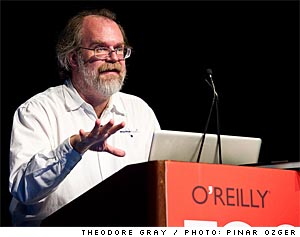Three days of intensive
discussion about the current state of publishing wrapped up Wednesday night in New York City. Let’s take a tour from start to end.
If I were to draw one point from the first session I attended, I would
say that metadata is a key competitive point for publishers. First,
facts such as who has reviewed a book, how many editions it has been
through, and other such things we call “metadata” can be valuable to
readers and institutions you want to sell content to. Second, it can
be valuable to you internally as part of curation (which I’ll get to
later). Basically, metadata makes content far more useful. But it’s
so tedious to add and to collate with other content’s metadata that
few people out in the field bother to add it. Publishers are
well-placed to do it because they have the resources to pay people for
that unappreciated task.
If I were to leap to the other end of the conference and draw one
point from the closing keynotes, I would say that the key to survival
is to start with the determination that you’re going to win, and to
derive your strategy from that. The closing keynoters offered a couple
strategies along those lines.

Kathy Sierra claimed she started her Head First
series with no vision loftier than to make money and beat the
competition. The key to sales, as she has often explained in her
talks and articles on “Creating Passionate Users,” is not to promote
the author or the topic but to promote what the reader could become.
Ben
Huh of I Can Has
Cheezburger said that one must plan a book to be a bestseller, the
way car or appliance manufacturers plan to meet the demands of their
buyers.
Thus passed the start and end of this conference. A lot happened in
between. I’ll cover a few topics in this blog.
Skills for a future publishing
There clearly is an undercurrent of worry, if not actual panic, in
publishing. We see what is happening to newspapers, we watch our
markets shrink like those of the music and television industries, and
we check our own balance sheets as Borders slides into
bankruptcy. I cannot remember another conference where I heard, as I
did this week, the leader of a major corporation air doubts from the
podium about the future of her company and her career.
Many speakers combatted this sense of helplessness, of course, but
their advice often came across as, “Everything is going haywire and
you can’t possibly imagine what the field will look like in a few
years, so just hang on and go with the flow. And by the way,
completely overturn your workflows and revamp your skill sets.”
Nevertheless, I repeatedly heard references to four classic skills
that still rule in the field of publishing. These skills were always
important and will remain important, but they have to shift and in
some ways to merge.
Two of these skills are research and sales. Although one was usually
expected to do research on the market and topic before writing and do
sales afterward, the talks by Sierra, Huh, and others suggested that
these are continuous activities, and hard to separate. The big buzz in
all the content industries is about getting closer to one’s audience.
There is never a start and end to the process.
The consensus is that casual exploitation of social
networking — sending out postings and updates and trying to chat with
readers online — won’t sell your content. Your readers are a market and
must be researched like one: using surveys, statistical analysis, and
so on. This news can be a relief to the thousands of authors who feel
guilty (and perhaps are made to feel guilty by their publishers)
because they don’t get pleasure from reporting things on Facebook
ranging from the breakfast cereal they ate to their latest brilliant
insight. But the question of how to bring one’s audience into one’s
project — a topic I’ll refer to as crowdsourcing and cover later — is a
difficult one.
Authoring and curation are even more fundamental skills. Curation has traditionally meant just making sure assets are safe, uncorrupted, and
ready for use, but it has broadened (particularly in the keynote
by Steve Rosenbaum) to include gathering information, filtering
and tagging it, and generally understanding what’s useful to different
audiences. This has always been a publisher’s role. In the age of
abundant digital content, the gathering and filtering functions can
dwarf the editorial side of publishing. Thus, although Thomson Reuters
has enormous resources of their own, they also generate value by
tracking the assets of many other organizations.
When working with other people’s material, curation, authoring, and
editing all start to merge. Perhaps organizing other people’s work
into a meaningful sequence is as valuable as authoring one’s own. In
short, curation adds value in ways that are different from authoring
but increasingly valid.
Capitalizing on the old
I am not ready to change my business cards from saying “Editor” to
“Curator” because that would make it look like I’m presiding over a
museum. Indeed, I fear that many publishers are dragged down by their
legacy holdings, which may go back a hundred years or more. I talked
to one publisher who felt like his time was mostly taken up with huge
holdings of classics that had been converted to digital form, and he
was struggling to find time just to learn how his firm could add the
kinds of interactivity, multimedia, links, and other enhancements that
people at the show were saying these digital works deserved.
We hope that no publishers will end up as museums, but some may have
to survive by partnering with newer, more limber companies that grok
the digital age better, rather as the publisher of T.S. Eliot’s
classic poem The Waste Land partnered with Touch Press, the
new imprint set up by Wolfram Research and discussed in a keynote
by Theodore Gray. Readers will expect more than plain old rendered
text from their glittery devices, and Gray’s immensely successful book
The Elements (which brought to life some very classic content, the
periodic table) shows one model for giving them what they want.
Two polar extremes
 Gray defined his formula for success as one of bringing together top
Gray defined his formula for success as one of bringing together top
talent in every field, rather as Hollywood film-makers do. Gray claims
to bring together “real authors” (meaning people with extraordinary
perspectives to offer), video producers with top industry
qualifications, and programmers whose skills go beyond the ordinary.
I can’t fault Gray’s formula — in fact, Head First follows the same
model by devoting huge resources to each book and choosing its topics
carefully to sell well — but if it was the only formula for success,
the book industry would put out a few hundred products each year like
Hollywood does. Gray did not offer this economic analysis himself, but
it’s the only way I see it working financially. Not only would this
shift squelch the thousands of quirky niche offerings that make
publishing a joy at present, I don’t consider it sustainable. How will
the next generation of top producers mature and experiment? If there
is no business model to support the long tail, they’ll never develop
the skills needed in Gray’s kind of business.
Business models are also a problem at the other extreme,
crowdsourcing. Everybody would like to draw on the insights of
readers. We’ve learned from popular books such as
The Wisdom of
Crowds and Wikinomics that our
public has valuable things to say, and our own works grow in value if
we mine them adeptly. There are innumerable conversations going on out
there, on the forums and the rating sites, and the social networks,
and publishers want to draw those conversations into the book. The
problem is that our customers are very happy on the communities they
have created themselves, and while they will drop in on our site to
rate a product or correct an error, they won’t create the digital
equivalent of Paris’ nineteenth-century cafe culture for us.
Because I have been fascinated for years by online information sharing
and have researched it
a fair amount, I made use of the conference in the appropriate way
by organizing a roundtable for anyone who was interested under the
subject, “Can crowdsourcing coexist with monetization?” Some of the
projects the participants discussed included:
- A book review site that pays experts for reviews, and then opens up
the site to the public for their comments. This approach uses
high-quality content to attract more content. - O’Reilly’s own Answers
site, which works similarly by sharing authors’ ideas as well as
excerpts from their books and draws postings from readers. - A site for baby product recommendations, put up by the publisher of
books on parenting. The publisher has succeeded in drawing large
groups of avid participants, and has persuaded volunteers to moderate
the site for free. But it hasn’t taken the next steps, such as
generating useful content for its own books from readers, or finding
ways to expand into information for parents of older children so the
publisher can keep them on the site. - Offering a site for teachers to share educational materials and
improve their curricula. In this case, the publisher is not interested
in monetizing the content, but the participants use the site to
improve their careers.
In between the premium offerings of Touch Press and the resale of
crowdsourced material lies a wide spectrum of things publishers can
do. At all points on the spectrum, though, traditional business
models are challenged.
The one strategic move that was emphasized in session after session
was to move our digital content to standards. EPUB, HTML5, and other standards are evolving and growing (sometimes beyond the scope, it
seems, of any human being to grasp the whole). If we use these
formats, we can mix and mingle our content with others, and thus take
advantage of partnerships, crowdsourcing, and new devices and
distribution opportunities.
Three gratifying trends
Trends can feel like they’re running against us in the publishing
industry. But I heard of three trends that should make us feel good:
reading is on the increase, TV watching is on the decrease (which will
make you happy if you agree with such analysts as Jerry Mander and
Neil Postman), and people want portability — the right to read their
purchases on any device. The significance of the last push is that it
will lead to more openness and more chances for the rich environment
of information exchange that generates new media and ideas. We’re in a
fertile era, and the first assets we need to curate are our own
skills.
Related:
